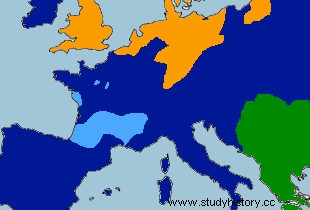Intro
The words of Pope Adrian VI, mixed with bitterness and nobility, however, came too late. Even as he wrote them, a dramatic and irreversible split had occurred in Christendom. This rupture was a major and dramatic event at the same time. Until then and for twelve centuries, the history of Europe had coincided with that of Christianity. How did we get here?
The causes of religious rupture
A changing world
The end of the Middle Ages and the Renaissance led to great upheavals in European societies:
- Politically, we are witnessing the decline of feudalism and the rise of nationalism. In France, the centralization of royal power which began under Louis XI was amplified during the following reigns, notably that of François I. Later, it will reach its peak with the absolute monarchy of Louis XIV.
- Culturally, the invention of the printing press enabled the transmission of new ideas and knowledge not only among scholars, but also among merchants and craftsmen. The printing press is the vector that will allow the exchange of new ideas.
The excesses of the Church
Renaissance men and women were at least as pious as those of the Middle Ages. Only, their expectations are now different, they are looking for a more direct relationship with God. The Church which plays the intermediary role is extremely powerful. She gradually moved away from the expectations of her followers. The Pope had become a sovereign, a Head of State who acted like kings. Moreover, the conduct of some prelates was far from exemplary. There were also bishops and abbots of monasteries who lived in luxury, forgetting the commandments they themselves preached. More and more believers reproached these clergymen for no longer being worthy of the office that God had entrusted to them. Already, several humanists like Erasmus had asked the Church to reform itself, to get rid of unworthy monks and these prelates without a vocation.
The Borgias
The Borgias are a powerful Italian family that gave birth to two popes as well as other important political figures. Affected by a black legend which accuses them of poisoning, fratricide, and incest, they symbolize all the decadence of the Church at the end of the Middle Ages.
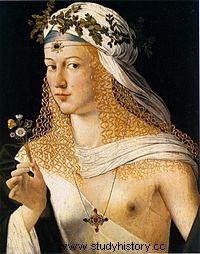
Lucrezia Borgia represented by Bartolomeo Veneto
The case of indulgences
At the beginning of the 16th century, the city of Rome was in the throes of change. The popes initiated major embellishment works, grandiose monuments were erected. The most important of these is St. Peter's Basilica. All the money needed for these projects was then taken from the faithful. The surest way to do this was to sell “indulgences”. Basically, an indulgence is a right of the faithful to obtain from God the remission of a certain number of years of purgatory, in exchange for meritorious actions accomplished during his existence. In general, it was necessary to perform a particular act to obtain the indulgence:to participate in a crusade, a pilgrimage, etc. But the greed of the clerics had allowed the introduction of the use of direct purchase of the indulgence. Some of the faithful were therefore trained to spend money to obtain the forgiveness of their sins. This practice triggered a scandal among many Christians who saw in it a manifestation of the corruption of the morals of the Church. The case of indulgences is the starting point of the Protestant reform movement. He points to a central notion for Protestants:the salvation of the soul.
Saint Peter's Basilica in Rome
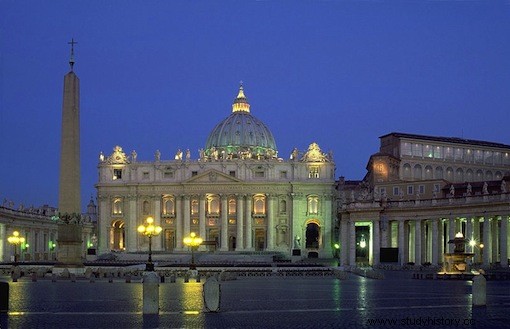
The root causes of the lag
The question of indulgences and the excesses of the clergy could not on their own have provoked a movement of the magnitude of the Reformation. In the Holy German Empire where the movement began, political and theological claims were grafted onto religious questions.
- Political causes:
- The German princes take a dim view of the eminent sovereignty of the pope. They are increasingly contesting church taxes, in particular the tithe which represents a tenth of the income of the subjects.
- The lower clergy, whose condition was miserable, resented the extreme wealth of the great German prelates.
- Theological causes: With the invention of the printing press (Gutenberg, 1450), the Bible is now printed and translated into the language of the peoples. The first Protestants then noticed the excesses of Catholic traditions around the adoration of the Virgin Mary and the saints. The latter evaluate the gap between the Holy Scriptures and the pontifical power, they wish to return to the fundamentals of the Bible.
Martin Luther, initiator of the Reformation
Wittenberg's 95 Theses
Martin Luther, son of a minor craftsman, was a German monk of the Augustinian order, a milieu heavily influenced by religious concerns. Indignant by the commercial drift of the Church with the affair of the Indulgences, he affixed, on the eve of All Saints' Day, in 1517, on the door of the church of the castle of Wittenberg (Saxony), 95 theses or arguments to be discussed. Besides condemning the selling of indulgences, Martin Luther also wanted to discuss deep theological issues:
- Soul Salvation :This is a question that concerned Luther personally. He thought that the salvation of the soul was a gift of God, obtained only by the faithful faith of the believer in Jesus Christ.
- Direct faith :Luther maintained that God, in the Bible, is addressed to each man. The free and personal interpretation of the Bible (the free examination) becomes one of the pivots of Protestant doctrine. This thesis rejected the authority of the Church, which defined itself as the sole interpreter of divine faith. According to Luther, each believer was a kind of priest, this is the idea of the “universal priesthood”. The papacy and the hierarchy of the Church were a human creation and not divine.
Martin Luther
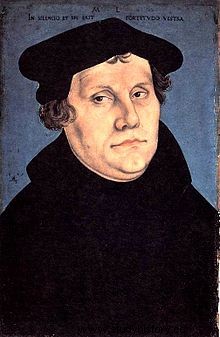
Martin Luther, by Lucas Cranach the Elder (1529)
The break with the powers
- The break with Rome :Luther did not stop there, he published "the great reforming writings" , four works that clarify his thought as well as the "Manifesto to the German nobility" . Very quickly, Luther became the most widely read author until around 1550. His adversaries, loyal to the pope, put all his books at the stake. Luther reacted with the same violence by publicly burning the pope's bull which condemned him. He thus signified his break with the Catholic Church, “the red prostitute of Babylon” as he called her. Unsurprisingly, he was then excommunicated by Pope Leo X on January 3, 1521.
- The break with the Empire :Martin Luther now had to face the Emperor Charles V. The emperor convened the diet of Worms in 1521 (general assembly of German princes). Luther presented himself to the assembly of Worms and maintained his positions. He was then banished from the empire, which means that anyone could now put him to death with impunity. But, among the assembly, Luther did not leave insensitive a part of the German nobility who also harbored grudges against the pope and the high clergy. The latter also saw the opportunity to seize the property of certain prince-bishops. Luther found among these German princes support and protection. The latter sent a protest to the emperor on his decision. From there was born the appellation of “Protestants” . At the castle of Wartburg where he had found refuge, Luther undertook to translate the Bible into German, it is a major cultural impact, it is the basis of modern German. The Reformation spread among the German principalities, dividing the empire of Charles V, already occupied by his wars against France. Luther and his friends laid the foundations of the new religion, many theological works were published, notably "The Augsburg Confession" of the reformer Melanchthon.
Main differences between Catholics and Protestants
The five pillars of Protestantism are expressed by five formulas in Latin, the solae . They all start with the adjective solus (alone) and symbolize the main differences with the Catholic faith:
- **Sola scriptura:** The Bible is the supreme authority in matters of doctrine. Protestants go back to the fundamentals of the Bible and reject Catholic traditions.
- **Sola fide:**Salvation is not given by the sacraments or religion but by faith alone. Rejection of the seven Catholic sacraments:Baptism, Confirmation, Eucharist, Penance, Anointing of the Sick, Holy Orders, and Marriage. Protestants recognize only three sacraments:baptism, marriage and the Eucharist (different from Catholics because there is no ceremony around the Ostia).
- **Sola gratia:** Salvation is obtained by divine grace, it is not the result of efforts or merits. This precept notably rejects the trade in Indulgences.
- **Solus Christus:** Jesus Christ is the only mediator between God and us. Rejection of papal authority and of the Church.
- **Soli Deo gloria:**God is the only one to worship and pray to. Protestants reject Catholic cults around the Virgin Mary and Saints (absent from the Bible).
Other reforms
The Anabaptists and the Peasants' Revolt
In Germany, some reformers went even further than Luther. One of them, Thomas Münzer, advocated a second baptism for adults and a redistribution of wealth to the poor. The Anabaptists, as they are called, are the forerunners of the anarchists, and reject the social hierarchy. The peasants of Alsace and southern Germany were enthusiastic and rose up attacking castles and monasteries. But Luther sided with the lords, and strongly condemned these revolts. He argued that the Bible should not be used to challenge the political and social order. He then encouraged the repression of the peasants, who were beaten in 1525 by the armies of the princes. The rebels are exterminated by the thousands. Another Anabaptist center was born in Westphalia in 1532, it was similarly crushed in blood. This affair provoked the abandonment of the support of the southern lords for the Lutheran reform which is equated with anarchy.
The Witch Hunt
Although the first agents of change in their time, Luther and Calvin were not exempt from the prejudices of their fellows, so both spoke out harshly against Jews and Turks. On the witch hunt which became popular from 1560 to 1650, Luther expressed himself in these terms:"You must not have pity on witches, as for me I will burn them" .
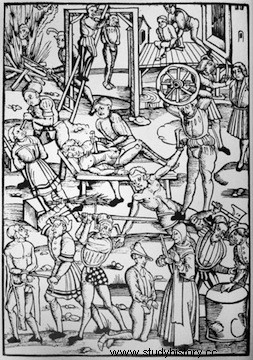
Woodcut showing tortured sorcerers, Tengler's Laienspiegel, Mainz, 1508.
The second Reformation, Calvinism
In the Latin countries and particularly in France and Spain, part of the Catholic clergy, influenced by the humanist current, undertook to reform the Church even before the pope gave the order. A part of these faithful underwent a strong reaction and the heretics were imprisoned, and sometimes condemned to the stake. In France, François Ier and Henri II, supported these movements of repression. From 1534, part of the French Protestants left the country to escape persecution, the majority emigrated to Switzerland. Among them was John Calvin. The Reformation was a great success in Switzerland, especially in Zurich, where the theologian Zwingli preached, who carried out an approach independent of Luther although similar. In French-speaking Switzerland, the city council of Geneva ratified its adherence to the new cult in 1536. Jean Calvin, who settled there in 1541, had set out his ideas in his work "Institution of the Christian religion" . He reached a conclusion more radical than that of Luther. Indeed, Calvin believed that souls were predestined by God to salvation or eternal damnation. It is the doctrine of salvation:“We exist for God and not for ourselves. This is why we must above all work for the honor of God”. These ideas were taken up by the council of the city of Geneva (Consistoire), made up of both pastors and lay people. Calvinism spread rapidly thanks to the Geneva missionaries. It was very successful in Switzerland, in France where it spread to Lyon, in the South and in the West, in Scotland (where it became Presbyterianism), in the Netherlands, in Bohemia and in Hungary.
John Calvin
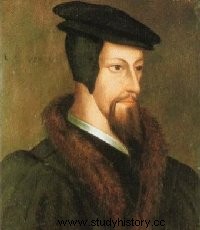
Portrait of John Calvin
The Anglican Reformation
Famous for his amorous escapades, Henry VIII Tudor of England asked Pope Clement VIII to dissolve his marriage with Catherine of Aragon (he was considering a new marriage with Anne Boleyn). The king met with a refusal from the pope. The sovereign then appointed one of his friends Archbishop of Canterbury and thus obtained what he desired. A year later, the king promulgated what was called the "Act of Supremacy" which was approved by Parliament (1534):it was the beginning of the Reformation in England. Henry VIII then proclaimed himself "Supreme Head of the Church and Clergy of England" and breaks all diplomatic relations with Rome. In reality, it was a schism (or separation) rather than a real reform. Indeed, the National Church of England, or Anglican Church, recognized its sovereign as head, while the pope kept his title of bishop of Rome. The dogmas and rites of this national Church differed very little from those of the Catholics. This separation was motivated by the following three factors:
- Politics:Breaking free from Roman tutelage
- Economic:Recover Church property for the royal treasury
- Satisfy the whims of a whimsical king (Henry VIII had six wives, two of whom he had beheaded).
Henry VIII of England
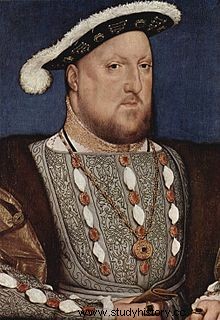
Henry VIII - by Hans Holbein 1536-1537 (Thyssen-Bornemisza Museum)
The reaction of Catholics:the Counter-Reformation
To respond to the expansion of Protestantism, the Catholic Church initiated its own Reformation. This movement was called the Counter-Reformation, in order to mark the opposition to the Protestant Reformation. The driving event of the recovery of the Church was the Council of Trent (a city in northern Italy), which was held between 1545 and 1563. This Catholic reform made it possible to regain positions lost in Italy, Spain, the Netherlands , as well as in France where the wars of religion played a decisive role throughout the 16th century. At the end of it, the face of the Church was really upset:
- Condemnation of Protestantism :All Protestant doctrines were condemned. The dogmas, that is to say the essential truths of the Catholic faith, were specified and summarized in the Credo.
- Disciplinary hardening :The Church also took a number of disciplinary measures against the excesses of its prelates. The accumulation of benefits was abolished and the bishops were henceforth imposed to remain in their bishopric.
- Training and preaching :Seminaries were created to ensure the training of priests. The council issued a certain number of works intended for the faithful such as the catechism and the missal. Finally, new religious orders were born in order to fight, by preaching and example, against Protestant doctrines.
- The Capuchin Friars Minor , from the Franciscan order, who want a return to the sources of Saint Francis of Assisi by taking a vow of poverty. The order which was abolished during the Revolution and then rehabilitated is the one from which Abbé Pierre came.
- The Society of Jesus (or Jesuit Order) created by the Spaniard Ignatius of Loyola, is characterized by strict obedience to the pope and a certain apostolic zeal. The Jesuits were great missionaries, preaching on all continents, notably in the Congo, Brazil and even China. The Company also became involved in education by opening several colleges.
Galileo, victim of the Counter-Reformation?
Galileo is an Italian scientist who notably perfected the astronomical telescope. He distinguished himself in particular in his defense of the heliocentric model of Copernicus (Sun at the center of the Universe). These ideas, which were strongly condemned by the Roman Catholic Church, earned him life imprisonment in addition to a public recantation of his remarks. At the time, some people like the Frenchman Descartes considered that Galileo was the victim of a plot by the Jesuits, who took revenge for the affront suffered by one of their own in a previous work by Galileo.
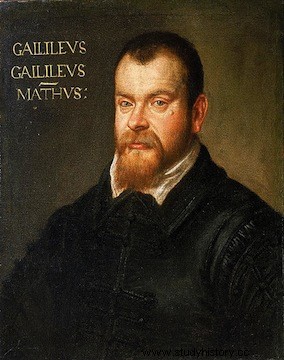
Galileo Galilei, by Domenico Robusti (1605)
Wars between Catholics and Protestants
The wars of religion in France
From the beginning of his reign, François I had concluded with Pope Leo X the Concordat of Bologna, signed in 1516. This granted absolute power to the King of France over the clergy (appointment of bishops, archbishops and cardinals). From then on, the king had no interest in encouraging a change of religion in the kingdom, despite the efforts of his Protestant sister Marguerite d'Angoulême (Queen of Navarre and mother of Jeanne d'Albret). The king, initially tolerant, became irritated after the "Affaire des Placards" in 1534:anticlerical posters were then posted in the streets of Paris, one of them even reached the room of François I in the castle of 'Amboise. From then on, Protestants began to be persecuted and the stakes were lit. King Henry II suppressed the Reformation even more than his father, as it spread. Thus, the Huguenots had no choice but to abjure or flee. But the persecutions only had the opposite effect and Protestants were particularly numerous in certain French regions:near Meaux, in Normandy, in Lyon near Geneva, in the South-West influenced by the Kingdom of Navarre and finally in La Rochelle where many merchants were present. The conciliation policy of Catherine de Medici and Michel de l'Hospital vexed the ultra-Catholics of Duke François de Guise who set fire to the powder by massacring Protestants in Wassy (1562). From then on, the conflict became politicized under the influence of the Protestant nobles, in particular the “princes of the blood” Condé and Navarre, and the Protestants managed to achieve some success. An ultra-Catholic League was formed around Duke Henri de Guise. This very powerful one had made it possible to drive out King Henri III from Paris (day of the barricades, 1588). But the Duke of Guise and then King Henry III were in turn assassinated, and the throne then returned to Prince Henry of Navarre (Henri IV). This one who had changed his religion several times, decided for Catholicism (“Paris is worth a mass”) in order to be consecrated in Chartres. He pacified the kingdom with the Edict of Nantes (1598) which authorized Protestant worship. But the religious conflicts continued during the following reigns. Thus, Richelieu besieged La Rochelle (1627-1628), a Protestant stronghold supported by England, before Louis XIV revoked his grandfather's Edict of Nantes (1685).
List of major Christian denominations
- Roman Catholicism
- Orthodoxy (following the East/West schism of 1054)
- Protestantism
- Lutheranism
- Calvinism
- Anglicanism
--> Interesting diagram on this site
Acts of cruelty
The religious conflicts of the 16th century plunged France into a situation of extremely violent civil war. If Protestants are the main victims of the waves of massacres, there have been some movements against Catholics. The best known is "the Michelade of Nîmes" which took place on September 29, 1567 (Saint Michael's Day) when nearly a hundred monks and clerics were massacred. But this is nothing compared to the massacre of Saint Bartholomew, which was carried out in absolute horror. Thus, Admiral de Coligny, who was bedridden on the night of August 23 to 24, 1572, was suddenly pierced by dagger and pistol blows. His lifeless body is then defenestrated, before the crowd of Paris seizes it to decapitate and emasculate it, then throw it into the Seine. He remains there for a few days before being exposed naked to the gibbet of Montfaucon. Encouraged, the towns of Province started their own massacres during the year 1572. In the end, one counted a total of approximately 10.000 died in all France. The persecutions of Protestants continued in the 17th and 18th centuries, thus under Louis XIV, we saw the appearance of "dragonnades", punitive expeditions of dragons (name of an army corps) organized by Minister Louvois. Subsequently, during the revolt of the Camisards (Protestant peasants of the Cévennes), the repression of the armies of the king was distinguished by the extermination of entire villages.
The gibbet of Montfaucon
The Montfaucon gibbet is a large stone building intended to expose the corpses of those sentenced to death for the purpose of deterrence. It was probably built at the request of Enguerrand de Marigny, who was to end up hanged and decomposed there for two years. Nicknamed "Forks of Great Justice", the gallows was erected a few meters from the current Place du Colonel-Fabien, in Paris. It could contain up to fifty remains.
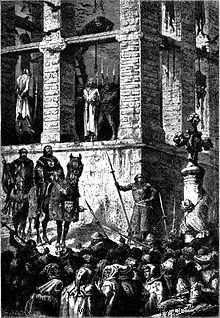
Engraving of the execution of Enguerrand de Marigny in 1315.
The political consequences in Europe
The geopolitical situation in Europe was greatly influenced by the religious conflicts of the different nations. Spain Catholic which was the dominant power in the 16th century with its immense colonial empire (Spanish Golden Age) lost its hegemony to two Protestant nations:
- The revolt of the Netherlands (Eighty Years' War) which led to the creation of the United Provinces and the accession of William of Orange. Through the development of its trade, this young republic also experienced its golden age (1584-1702).
- England of Elizabeth I who crushed the Invincible Armada of Philip II (1588) thus announcing the beginning of the maritime domination of the Navy . In Germany , the Habsburgs had to face the expansion of Protestantism among the German princes of the north. Long conflicts weakened the Holy Empire, in 1555, the peace of Augsburg consecrates the religious division of the country. More pragmatic, France , which remained catholic, continues its fight against Habsbourg of Spain and Germany, however co-religionists. In the 17th century, the whole of Europe was torn apart during the Thirty Years' War . The conflict ended with the Treaty of Westphalia (1648) which recognizes the three confessions, Catholic, Lutheran and Calvinist in the Holy Empire and which reshapes the borders of Europe for many years.
Map of Europe at the end of the 16th century

